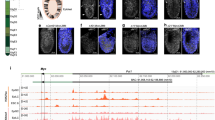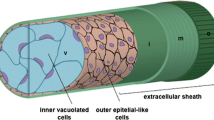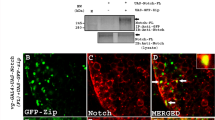Abstract
In the Drosophila embryo, the mesectoderm corresponds to a single row of cells abutting the mesoderm. It is specified by the expression of the single-minded (sim) gene. The information that precisely positions the sim-expressing cells along the dorso-ventral axis is incompletely understood. Previous studies have shown that Dorsal and Twist activate sim expression in a large ventral domain, while two negative regulators, Snail (Sna) and Suppressor of Hairless [Su(H)], repress sim expression in the mesoderm and neuroectoderm, respectively. Repression by Su(H) is relieved in the presumptive mesectoderm by Notch signaling. In this paper, we show that Sna also has a positive regulatory function on sim expression in the presumptive mesectoderm. This positive effect of Sna depends on the Su(H)-binding sites within the sim promoter, suggesting that Sna regulates Notch signaling. In addition, we find that Delta is endocytosed together with the extracellular domain of Notch. The endocytosis of Delta is only seen in the mesoderm and requires the activity of the sna and neuralized (neur) genes. Interestingly, the Neur-mediated endocytosis of Delta has recently been shown to be sufficient for the non-autonomous activation of Notch target genes in wing imaginal discs. We therefore propose a novel model in which Sna positions the mesectoderm via its dual regulatory activity. In this model, Sna cell-autonomously represses sim expression in the mesoderm and relieves Su(H)-dependent repression in a cell non-autonomous fashion by promoting the Neur-dependent endocytosis of Delta in the mesoderm.






Similar content being viewed by others
References
Ashraf SI, Ip YT (2001) The Snail protein family regulates neuroblast expression of inscuteable and string, genes involved in asymmetry and cell division in Drosophila. Development 128:4757–4767
Ashraf SI, Hu X, Roote J, Ip YT (1999) The mesoderm determinant snail collaborates with related zinc-finger proteins to control Drosophila neurogenesis. Embo J 18:6426–6438
Boulianne GL, de la Concha A, Campos-Ortega JA, Jan LY, Jan YN (1991) The Drosophila neurogenic gene neuralized encodes a novel protein and is expressed in precursors of larval and adult neurons. Embo J 10:2975–2983
Bray S, Furriols M (2001) Notch pathway: making sense of Suppressor of Hairless. Curr Biol 11:R217–R221
Cai Y, Chia W, Yang X (2001) A family of snail-related zinc finger proteins regulates two distinct and parallel mechanisms that mediate Drosophila neuroblast asymmetric divisions. Embo J 20:1704–1714
Campos-Ortega JA, Hartenstein V (1997) The embryonic development of Drosophila melanogaster. Springer, Berlin Heidelberg New York
Cowden J, Levine M (2002) The Snail repressor positions Notch signaling in the Drosophila embryo. Development 129:1785–1793
Fehon RG, Johansen K, Rebay I, Artavanis-Tsakonas S (1991) Complex cellular and subcellular regulation of notch expression during embryonic and imaginal development of Drosophila: implications for notch function. J Cell Biol 113:657–669
Hemavathy K, Meng X, Ip YT (1997) Differential regulation of gastrulation and neuroectodermal gene expression by Snail in the Drosophila embryo. Development 124:3683–3691
Hicke L (2001) Ubiquitin and proteasomes: protein regulation by monoubiquitin. Nat Rev Mol Cell Biol 2:195–201
Ip YT, Park RE, Kosman D, Bier E,. Levine M (1992a) The dorsal gradient morphogen regulates stripes of rhomboid expression in the presumptive neuroectoderm of the Drosophila embryo. Genes Dev 6:1728–1739
Ip YT, Park RE, Kosman D, Yazdanbakhsh K, Levine M (1992b) dorsal-twist interactions establish snail expression in the presumptive mesoderm of the Drosophila embryo. Genes Dev 6:1518–1530
Kasai Y, Nambu JR, Lieberman PM, Crews ST (1992) Dorsal-ventral patterning in Drosophila: DNA binding of snail protein to the single-minded gene. Proc Natl Acad Sci USA 89:3414–3418
Kasai Y, Stahl S, Crews S (1998) Specification of the Drosophila CNS midline cell lineage: direct control of single-minded transcription by dorsal/ventral patterning genes. Gene Express 7:171–189
Kooh PJ, Fehon RG, Muskavitch MA (1993) Implications of dynamic patterns of Delta and Notch expression for cellular interactions during Drosophila development. Development 117:493–507
Kosman D, Ip YT, Levine M, Arora K (1991) Establishment of the mesoderm-neuroectoderm boundary in the Drosophila embryo. Science 254:118–122
Lai EC, Deblandre GA, Kintner C, Rubin GM (2001) Drosophila neuralized is a ubiquitin ligase that promotes the internalization and degradation of delta. Dev Cell 1:783–794
Lecourtois M, Schweisguth F (1995) The neurogenic suppressor of hairless DNA-binding protein mediates the transcriptional activation of the enhancer of split complex genes triggered by Notch signaling. Genes Dev 9:2598–2608
Leptin M (1991) twist and snail as positive and negative regulators during Drosophila mesoderm development. Genes Dev 5:1568–1576
Leptin M (1999) Gastrulation in Drosophila: the logic and the cellular mechanisms. Embo J 18:3187-3192
Leptin M, Grunewald B (1990) Cell shape changes during gastrulation in Drosophila. Development 110:73–84
Leptin M, Roth S (1994) Autonomy and non-autonomy in Drosophila mesoderm determination and morphogenesis. Development 120:53–859
Lloyd TE, Atkinson R, Wu MN, Zhou Y, Pennetta G, Bellen HJ (2002) Hrs regulates endosome membrane invagination and tyrosine kinase receptor signaling in Drosophila. Cell 108:261–269
Lopez-Schier H, St Johnston D (2001) Delta signaling from the germ line controls the proliferation and differentiation of the somatic follicle cells during Drosophila oogenesis. Genes Dev 15:1393–1405
Martin-Bermudo MD, Carmena A, Jimenez F (1995) Neurogenic genes control gene expression at the transcriptional level in early neurogenesis and in mesectoderm specification. Development 121:219–224
Morel V, Schweisguth F (2000) Repression by Suppressor of Hairless and activation by Notch are required to define a single row of \textit{single-minded} expressing cells in the Drosophila embryo. Genes Dev 14:377–388
Morel V, Lecourtois M, Massiani O, Maier D, Preiss A, Schweisguth F (2001) Transcriptional repression by suppressor of hairless involves the binding of a hairless-dCtBP complex in Drosophila. Curr Biol 11:789–792
Nambu JR, Franks RG, Hu S, Crews ST (1990) The single-minded gene of Drosophila is required for the expression of genes important for the development of CNS midline cells. Cell 63:63–75
Nambu JR, Lewis JO, Wharton KA Jr, Crews ST (1991) The Drosophila single-minded gene encodes a helix-loop-helix protein that acts as a master regulator of CNS midline development. Cell 67:1157–1167
Parks AL, Klueg KM, Stout JR, Muskavitch MA (2000) Ligand endocytosis drives receptor dissociation and activation in the Notch pathway. Development 127:1373–1385
Pavlopoulos E, Pitsouli C, Klueg KM, Muskavitch MA, Moschonas NK, Delidakis C (2001) neuralized encodes a peripheral membrane protein involved in delta signaling and endocytosis. Dev Cell 1:807–816
Price BD, Chang Z, Smith R, Bockheim S, Laughon A (1993) The Drosophila neuralized gene encodes a C3HC4 zinc finger. Embo J 12:2411–2418
Raiborg C, Bache KG, Gillooly DJ, Madshus IH, Stang E, Stenmark H (2002) Hrs sorts ubiquitinated proteins into clathrin-coated microdomains of early endosomes. Nat Cell Biol 4:394–398
Rao Y, Vaessin H, Jan L, Jan Y (1991) Neuroectoderm in Drosophila embryos is dependent on the mesoderm for positioning but not for formation. Genes Dev 5:1577–1588
Roth S, Stein D, Nusslein-Volhard C (1989) A gradient of nuclear localization of the dorsal protein determines dorsoventral pattern in the Drosophila embryo. Cell 59:1189–1202
Rusch J, Levine M (1996) Threshold responses to the dorsal regulatory gradient and the subdivision of primary tissue territories in the Drosophila embryo. Curr Opin Genet Dev 6:416–423
Sakamoto K, Ohara O, Takagi M, Takeda S, Katsube K (2002) Intracellular cell-autonomous association of Notch and its ligands: a novel mechanism of Notch signal modification. Dev Biol 241:313–326
The I, Bellaiche Y, Perrimon N (1999) Hedgehog movement is regulated through tout velu-dependent synthesis of a heparan sulfate proteoglycan. Mol Cell 4:633–639
Thomas U, Speicher SA, Knust E (1991) The Drosophila gene Serrate encodes an EGF-like transmembrane protein with a complex expression pattern in embryos and wing discs. Development 111:749–761
Yeh E, Zhou L, Rudzik N, Boulianne GL (2000) Neuralized functions cell autonomously to regulate Drosophila sense organ development. Embo J 19:4827–4837
Yeh E, Dermer M, Commisso C, Zhou L, McGlade CJ, Boulianne GL (2001) Neuralized functions as an E3 ubiquitin ligase during Drosophila development. Curr Biol 11:1675–1679
Acknowledgements
We thank H. Bellen, C. Delidakis, E. Lai, M. Leptin, M. Muskavitch, S. Roth, G. Rubin, D. St. Johnston, the Bloomington Stock Center, the Tübingen stock center and the Developmental Studies Hybridoma Bank (University of Iowa) for providing fly stocks and antibodies. We thank A. Martinez-Arias and M. Leptin for helpful discussions. We also thank Y. Bellaïche, S. Lee, V. Orgogozo and I. Stüttem for critical reading. This work was supported by specific grants from the Centre National de la Recherche Scientifique, the Ministère de la Recherche (ACI Program) and the Association pour le Recherche contre le Cancer (ARC 5575).
Author information
Authors and Affiliations
Corresponding author
Additional information
Edited by C. Desplan
Rights and permissions
About this article
Cite this article
Morel, V., Le Borgne, R. & Schweisguth, F. Snail is required for Delta endocytosis and Notch-dependent activation of single-minded expression. Dev Genes Evol 213, 65–72 (2003). https://doi.org/10.1007/s00427-003-0296-x
Received:
Accepted:
Published:
Issue Date:
DOI: https://doi.org/10.1007/s00427-003-0296-x




